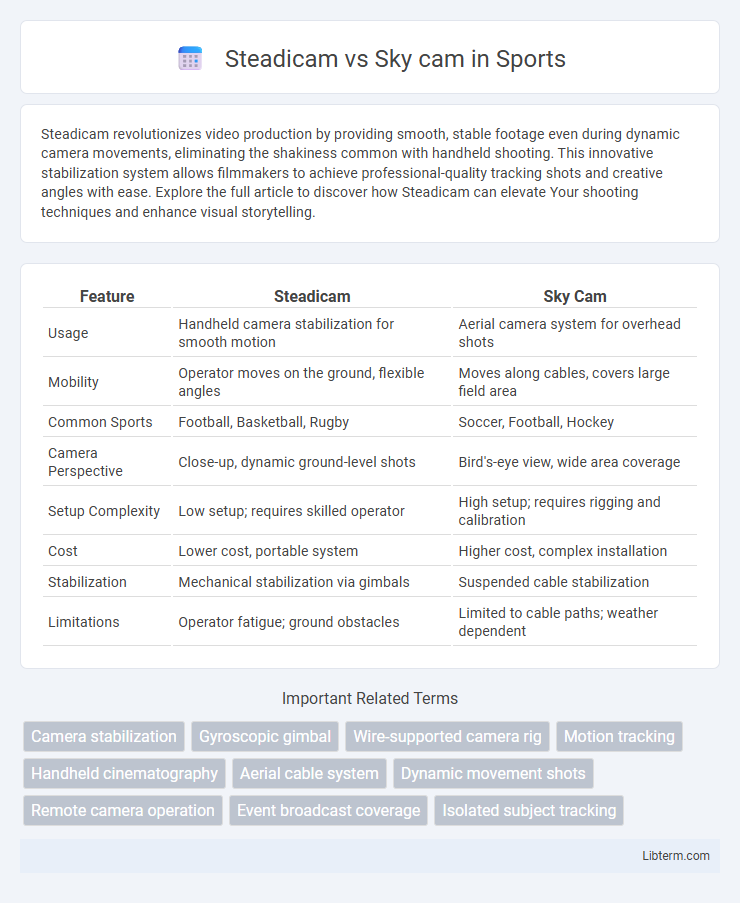Steadicam revolutionizes video production by providing smooth, stable footage even during dynamic camera movements, eliminating the shakiness common with handheld shooting. This innovative stabilization system allows filmmakers to achieve professional-quality tracking shots and creative angles with ease. Explore the full article to discover how Steadicam can elevate Your shooting techniques and enhance visual storytelling.
Table of Comparison
| Feature | Steadicam | Sky Cam |
|---|---|---|
| Usage | Handheld camera stabilization for smooth motion | Aerial camera system for overhead shots |
| Mobility | Operator moves on the ground, flexible angles | Moves along cables, covers large field area |
| Common Sports | Football, Basketball, Rugby | Soccer, Football, Hockey |
| Camera Perspective | Close-up, dynamic ground-level shots | Bird's-eye view, wide area coverage |
| Setup Complexity | Low setup; requires skilled operator | High setup; requires rigging and calibration |
| Cost | Lower cost, portable system | Higher cost, complex installation |
| Stabilization | Mechanical stabilization via gimbals | Suspended cable stabilization |
| Limitations | Operator fatigue; ground obstacles | Limited to cable paths; weather dependent |
Introduction to Steadicam and Sky cam
Steadicam offers smooth, stabilized camera movement through a wearable rig that isolates the operator's motion, ideal for handheld shots in dynamic environments. Skycam operates as a suspended, computer-controlled cable system allowing aerial camera movement across large venues, providing unique overhead perspectives. Both technologies enhance cinematic storytelling by delivering fluid and versatile camera angles tailored to diverse production needs.
Key Differences Between Steadicam and Sky cam
Steadicam offers smooth, handheld camera movement with an operator-controlled stabilizing arm ideal for ground-level shots and dynamic tracking. Sky cam is a cable-suspended system enabling aerial perspectives by moving a camera across three-dimensional space above the scene. Key differences include Steadicam's operator-based flexibility and portability versus Sky cam's mechanized, large-area coverage and overhead vantage points.
Steadicam: Technology and Operation
Steadicam technology utilizes a harness and articulated arm system to isolate camera movement from operator motion, delivering smooth, fluid shots in dynamic environments. Its operation relies on counterweights and gimbals that balance the camera, allowing precise control and stability during complex tracking shots. This hands-on approach provides filmmakers with versatile angles and natural motion without the need for fixed tracks or rigs.
Sky cam: Technology and Operation
Sky cam employs a computer-controlled cable-suspended camera system, enabling dynamic, aerial shots with smooth, multi-directional movement over large areas such as sports arenas. This technology uses motorized winches and real-time stabilization algorithms to maintain steady footage while allowing rapid position changes in three-dimensional space. Unlike the Steadicam, which is handheld and operator-dependent, Sky cam's automated system provides expansive coverage and versatility, capturing unique perspectives from above with high precision and minimal operator fatigue.
Use Cases: When to Choose Steadicam
Steadicams excel in dynamic, close-up shots requiring smooth, fluid camera movements, making them ideal for fast-paced action scenes or intimate character moments. They provide flexibility in tight or crowded environments where operator mobility is crucial, such as indoor sets or live events. Sky cams are better suited for expansive aerial views, while Steadicams maintain stability and precision in handheld cinematography.
Use Cases: When to Choose Sky cam
Sky cam is ideal for capturing dynamic aerial shots in large-scale sports events, concerts, and outdoor festivals where overhead views enhance audience experience. It excels in providing expansive, sweeping perspectives and tracking fast-moving subjects from above, which Steadicam cannot achieve due to its ground-level operation. Choose Sky cam when the production demands high-altitude, uninterrupted motion shots with wide spatial coverage.
Image Quality and Stability Comparison
Steadicam systems deliver exceptional image stability through advanced mechanical stabilization, minimizing camera shakes and allowing smooth, fluid movements ideal for close-up shots and dynamic scenes. SkyCam employs cable-suspended technology providing aerial perspectives and stable long-range tracking, although minor vibrations can occur due to wind or cable tension. Image quality depends mainly on the camera used, but Steadicam often supports heavier, higher-end cinema cameras, potentially offering superior image resolution and control compared to the lighter cameras typically mounted on SkyCam rigs.
Cost and Accessibility Analysis
Steadicam systems typically range from $15,000 to $70,000, offering portability and ease of use for solo operators, making them more accessible for independent filmmakers and small productions. Skycam installations, often exceeding $100,000, require specialized rigging, multiple operators, and dedicated space, thereby limiting accessibility primarily to large-scale productions and sports broadcasting. The significant cost difference and operational complexity highlight Steadicam's advantage in budget-conscious and flexible shooting scenarios compared to the high-end, dynamic capabilities of Skycam systems.
Pros and Cons of Steadicam vs Sky cam
Steadicam offers unparalleled fluidity and close-up control for dynamic, ground-level shots, providing operators with precise stabilization and versatility in tight spaces. Sky cam excels in capturing expansive aerial views and sweeping sports action with its cable-suspended system, though it requires extensive setup and lacks the intimate proximity of handheld shots. While Steadicam provides organic, immersive perspectives, Sky cam is ideal for broad, dramatic visuals but is limited by its fixed flight paths and higher operational complexity.
Conclusion: Which is Best for Your Filming Needs?
Steadicam excels in providing smooth, fluid camera movements ideal for close-up shots and dynamic scenes requiring operator control, making it perfect for narrative films and live performances. Sky cam offers expansive, aerial perspectives and sweeping overhead views crucial for large-scale sports events and action sequences where spatial context is key. Choosing between Steadicam and Sky cam depends on your project's demands for mobility, shot style, and environment size to achieve the most impactful visual storytelling.
Steadicam Infographic

 libterm.com
libterm.com